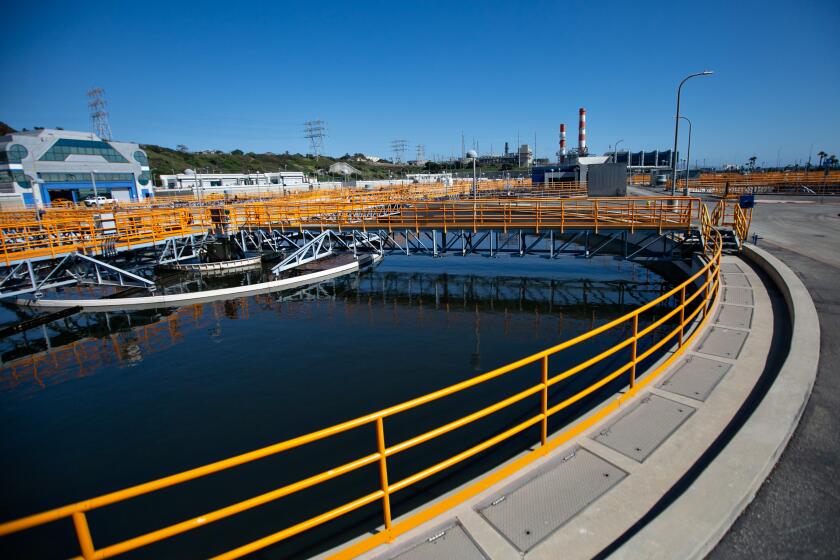Hopes for Cleanup Boat Run Aground : Oil: All that separates a Simi Valley inventor and his dream of a new, less costly way to mop up spills is money for prototype.
Simi Valley resident John Bartha knew that there had to be a better way to separate oil from water after reading about the painstakingly difficult and expensive way crews tried to mop up the enormous oil spill caused by the Exxon Valdez in Alaska.
“It was so hopeless on the Exxon spill that my cousin and I came up with a way,” said Bartha, a Hungarian-born engineer. “We said, ‘There has to be something better than broomsticks.’ ”
The desire to find a more effective cleanup method led Bartha to theorize that the molecular similarities between oil and hot wax would cause the two substances to bond together and then make for easy removal after the wax had solidified in cold water.
“I started experimenting and every time it was like, ‘It works, it works, there must be something wrong,’ ” he said.
Over time and repeated testing, Bartha came to terms with the potential of his idea--both personal and financial--and designed a $10-million, self-sufficient, seagoing vessel containing all the equipment necessary to mop up spills for about $385 a gallon. He says that is a cost dramatically less than the roughly $20,000 a gallon spent using existing technologies.
But that was the last bright spot for Bartha.
In the years since developing his patented process, the first-time inventor has sent hundreds of letters to government officials and private companies in a bid to raise enough money to build the prototype vessel. He has yet to raise a dime.
“We’ve been trying to sell the idea to the government and the public and gotten nowhere fast,” he said. “I’m just saying, ‘Here’s a solution for a billion-dollar headache, take it.’ They all like it. They all say it’s interesting technology, but no money.”
He has written to Vice President Al Gore, California Gov. Pete Wilson, U. S. Sen. Barbara Boxer (D-Calif.), the U. S. Coast Guard, and myriad other public and private officials and groups in search of funding--all to no avail.
An April 14 letter from Gore in response to Bartha’s proposal is typical of the reactions he gets.
“I appreciate being informed in this way,” Gore wrote. “The information you provided certainly appears to contain ideas that merit careful attention. I will retain this material for future consideration as the President and I work on related policies and programs.”
*
Bartha considers such letters nothing more than a one-page brush-off. “They’re patting me on the shoulder; that’s all there is to it,” he said.
Skip Onstad, general manager for the Marine Spill Response Corp.’s Southwest region, agrees.
“He’s not going to find any support writing governors and congressmen; that’s futile,” Onstad said. “They’ll be polite, but in all the years I’ve been in this business, I’ve never seen any new product given any advantage because of political pressure. What he has to do is get inside the spill response community, write papers for the oil spill conferences and things of that nature, and create interest.”
Bartha said he has tried to do just that. But he said he has come across great reluctance on the part of some officials to review his written proposal. And without a working prototype, few are willing to even consider his idea.
For his part, Onstad said that, chemically, the process will work, but that whether Bartha can actually use it to clean up an oil spill remains to be seen.
“I want to look at the whole system, not just the idea of spraying hot wax on oil,” Onstad said. “What’s the concept, and has he really done anything in terms of containing and cleaning up oil spills? What he has done is change the form of the oil from a liquid to a solid. Then what?”
Onstad also said the bulk of the limited dollars available for research and development on oil spill cleanup is usually routed toward improving the tools used in existing technology, not taking a chance on a new, theoretical solution.
Bartha has also failed to win any financial support from another potential source, the Coast Guard.
Robert Hiltabrand, a senior environmental scientist for the Coast Guard, said Bartha’s idea has merit, but is unlikely to be taken seriously until Bartha finds some way to build his $10-million prototype.
“We know the concept will work; we have no problem with that,” Hiltabrand said. “But we need to see something more than words on a paper. We need a prototype demonstration before we would start looking at it.”
The hitch so far has been in raising the capital necessary to make that possible, and even Hiltabrand sympathized with the limited availability of public research money in this area.
Both the inventor and Hiltabrand agree that the financing needed to build the first boat will most likely come from private enterprise, such as investors willing to take a chance on the strength of an idea.
“He’s got to get some movie stars to go in with him on this or something,” Hiltabrand said. “The concept will work, but he’s got to get the funds to build the boat, and that’s not going to be easy to do.”’
*
Another critical question is whether Bartha can reproduce results achieved in a small back-yard pool in the rolling, unpredictable ocean.
“He may not be able to pick it up,” Hiltabrand said of oil on the open ocean. “What I would want to see is this thing working out at sea. If he could demonstrate it in something other than a swimming pool, build a small boat, we would probably send a representative to look at it.”
Bartha said he is sure that his patented technology works. He just wishes that he could find someone with money who shares that vision.
He said his choice of vessel, a 125-foot, catamaran-type boat, is inherently stable and will allow the oil to be sprayed with wax and collected between the hulls even in choppy seas.
“This is not just something I fantasized about,” Bartha said. “These are very stable surface boats. . . . I’m not redesigning the wheel. I’m just putting in a system that will do my wax.”
Under his system, hot wax would be sprayed on the oil between the hulls; both substances would solidify together in seconds, and a separator would filter out the oil and reuse the wax over and over again, while the oil is bagged for easy pickup.
Bartha said that one of his boats could remove 140,000 gallons of oil in 24 hours, and that only three such boats would have cleaned up the Valdez spill in about a week.
Unfortunately for him, Bartha’s calculations have remained merely theoretical.
“It’s quite frustrating that an idea like this, simple, very straightforward and something that’s needed, is not taking place, or at least takes so much time,” Bartha said. “People who are friendly say, ‘Well, Graham Bell--it took him two years to get his phone working and today we can’t do without it.’ ”
More to Read
Start your day right
Sign up for Essential California for news, features and recommendations from the L.A. Times and beyond in your inbox six days a week.
You may occasionally receive promotional content from the Los Angeles Times.






